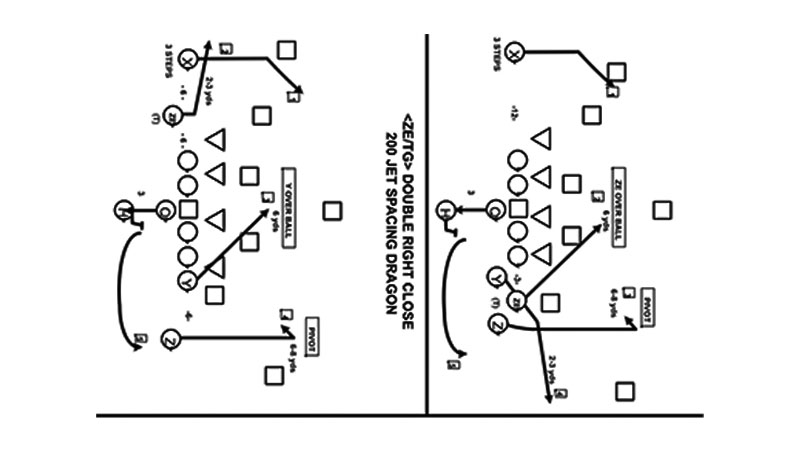In the dynamic world of American football, the West Coast offense stands out as a revolutionary strategy that prioritizes passing over running. This innovative approach has transformed the game, emphasizing quick, short passes to move the ball efficiently down the field.
By focusing on precision and timing, teams using the West Coast offense can exploit defensive weaknesses and control the tempo of the game.
A key element of this strategy is the dual-threat quarterback, who can both pass and run effectively. Notable players like Michael Vick and Russell Wilson have showcased the power of this approach, using their agility to paralyze aggressive defenses.
Additionally, play-action passes play a crucial role in the West Coast offense, deceiving defenders and creating opportunities for receivers to get open. This blend of tactics has made the West Coast offense a formidable and enduring force in football.
Origins and Evolution of the West Coast Offense
The West Coast offense transformed the landscape of American football. It introduced a strategic shift towards passing, emphasizing precision, timing, and field control.
The Birth of a Strategy
Originally, the West Coast offense referred to Don Coryell’s Air Coryell system, which he popularized with the San Diego Chargers. This system broke the conventional reliance on the running game, focusing instead on passing to maintain possession.
Traditional offensive playbooks aimed to run first to open up passing lanes. Coryell’s approach deviated, pioneering a philosophy where quick, short passes methodically moved the ball down the field.
This strategy aimed to spread the defense, creating opportunities and mismatches in speed, size, or numbers.
Key Innovators and Development
Bill Walsh redefined the West Coast offense with the San Francisco 49ers by using short, precise passes to control the clock, differing from Coryell’s deep pass routes.
Coaches like Sid Gillman, Don Coryell, Walsh, and LaVell Edwards won championships with their pass-heavy offenses, emphasizing field spreading and mismatches.
Gary Kubiak also achieved success with these strategies, winning Super Bowl 50. These innovations shaped the modern West Coast offense and influenced contemporary football.
Principles of the West Coast Offense
The West Coast offense revolutionized American football by emphasizing precision passing and strategic ball control. Its core principles reflect a combination of short, timed passing plays and effective utilization of player skills to maintain possession and exploit defenses.
Emphasis on Passing
The primary focus of the West Coast offense is its passing game. Unlike traditional run-heavy systems, this strategy relies on quick, short passes to move the ball downfield.
By using high-percentage throws, it keeps the defense on its heels and opens up opportunities for big plays. This method not only spreads the field horizontally but also allows for strategic vertical attacks.
The Role of the Quarterback
In the West Coast offense, the quarterback’s role is paramount. He must possess a quick release, accurate arm, and strong decision-making skills. The quarterback often executes three-step and five-step drops, delivering the ball with precision and timing.
This system leverages the quarterback’s ability to read defenses quickly and find the open receiver, making it essential for him to be both smart and versatile.
Strategic Elements of the West Coast Offense
The West Coast offense is renowned for its strategic elements that emphasize precision passing, timing, and versatile formations to control the game. Here’s a detailed exploration of these strategic elements:
Common Plays and Formations
The West Coast offense optimizes efficiency and exploits defensive gaps through specific plays and formations like the 21 personnel set, featuring two backs, one tight end, and two wide receivers.
This balanced setup supports both running and passing plays, keeping the defense uncertain. The strategy includes rhythm-based three-step and five-step dropbacks for the quarterback, aligning with receiver routes for quick, accurate passes.
Key plays such as slant routes, out routes, and screen passes aim to spread the defense horizontally and create mismatches, with each play leveraging precise timing and strategic positioning.
The Importance of Timing and Precision
Timing and precision are crucial in the West Coast offense, requiring quarterbacks to release the ball within seconds to avoid sacks and reduce pressure on the offensive line.
Perfect synchronization between the quarterback’s dropback and receiver routes enhances pass completion rates. The offense relies on the quarterback’s ability to make quick, accurate throws, and the mobility and decision-making to read defenses.
Receivers must run precise routes to create separation and catch passes under defensive pressure, enabling continuous ball movement and control of the game’s pace.
Impact on Modern Football
The West Coast offense revolutionized offensive strategies in American football, significantly impacting how modern teams approach the game.
Influence in NFL Teams
NFL teams widely adopted the West Coast offense principles, with many successful franchises implementing its core tactics. Coaches like Mike Holmgren and Andy Reid have used its strategies to achieve consistent success.
For instance, teams like the Green Bay Packers and the Kansas City Chiefs have applied short, precise passing plays to control the clock and systematically dismantle defenses.
This philosophy has enabled teams to maintain possession and dictate the game’s pace, contributing to their overall success.
Adaptations and Variations
While the West Coast offense’s foundational principles remain intact, numerous adaptations and variations emerged. Coaches have integrated elements from other offensive schemes, evolving the strategy to suit their personnel.
For example, some variations emphasize more mobile quarterbacks to exploit defenses with both passing and rushing threats.
Others incorporate more vertical passing elements, creating a hybrid approach that blends traditional West Coast offense strategies with deeper, downfield attacks. These adaptations showcase the offense’s flexibility and enduring influence on modern football.
The Future of the West Coast Offense
The West Coast offense continues to adapt in response to modern football demands. Future developments promise to enhance its effectiveness even further.
Evolution In Tactics
Coaches innovate to keep defenses off balance by integrating spread concepts into the West Coast offense, using shotgun formations for quicker quarterback reads, and exploiting mismatches with smaller, faster receivers.
RPO plays add complexity, while offensive line protection schemes have evolved with more zone blocking to complement the quicker passing game, making offenses unpredictable and efficient.
Technological Influences
Advances in technology are essential for the future of football offense. Teams use data analytics to enhance play-calling and player performance, while wearable technology monitors player health to prevent injuries.
Virtual reality provides realistic training without physical strain, and advanced video analysis allows coaches to study opponents’ defenses better. Simulation software helps quarterbacks visualize defensive schemes, improving decision-making.
These technological advancements ensure that the West Coast offense remains a powerful strategy in modern football.
Frequently Asked Questions
Who are the key figures behind the West Coast offense?
Key figures include Sid Gillman, Don Coryell, Bill Walsh, and LaVell Edwards. They have significantly influenced modern football strategies with precision passing and exploiting defensive weaknesses.
How does the West Coast offense control the game’s pace?
The West Coast offense uses specific plays and formations to create mismatches and maintain control of the game’s pace, effectively dictating the flow and tempo.
Have NFL teams widely adopted the West Coast offense?
Yes, many NFL teams have adopted its principles. Coaches like Mike Holmgren and Andy Reid have used its tactics for consistent success.
How has the West Coast offense evolved over time?
The offense has integrated spread concepts, RPO plays, and zone blocking. This evolution has enhanced its versatility and unpredictability.
How has technology impacted the West Coast offense?
Technological advancements such as data analytics, wearable technology, virtual reality, and simulation software have refined the West Coast offense, ensuring its continued effectiveness.
Conclusion
The West Coast offense remains a cornerstone of modern football strategy. Its emphasis on precision passing and ball control has set the standard for offensive play.
Coaches and players continue to innovate within this framework, integrating new technologies and concepts to stay ahead of the competition.
As the game evolves, the principles of the West Coast offense will undoubtedly continue to influence how teams approach the sport, ensuring its lasting impact on American football.
This versatile system not only maximizes player performance but also adapts to varying defensive schemes, making it a critical part of any successful playbook.
Future adaptations will likely incorporate more data analytics and personalized strategies, further cementing the West Coast offense as an indispensable tool in football’s ever-changing landscape.








Ashley Hopkinson